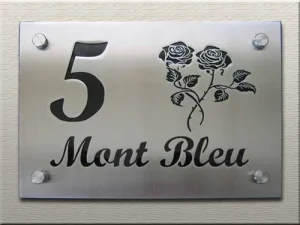If you're looking for a durable and long-lasting way to label or mark your products, stainless steel etching plates may be the solution you need. Etching is a process that uses acid or chemicals to remove layers of metal to create a design or pattern. Stainless steel is an excellent material for etching because it is strong, corrosion-resistant, and can withstand harsh environments.
Stainless steel etching plates are used in a variety of industries, including aerospace, automotive, medical, and electronics. They are commonly used for nameplates, labels, and identification tags because of their durability and resistance to wear and tear. The etching process allows for intricate designs and detailed lettering, making them ideal for branding and product identification. Additionally, stainless steel etching plates can be customized to fit specific shapes and sizes, making them versatile for a range of applications.

If you are looking for a way to create intricate designs or markings on stainless steel, then etching is an excellent option. Etching is a process that involves selectively removing material from the surface of a metal plate using either chemical or physical techniques. In this section, we will discuss the basics of stainless steel etching, including the materials and tools required, the chemical etching process, and physical etching techniques.
To start etching stainless steel, you will need the following materials and tools:
Chemical etching is a process that involves using an etching solution to selectively remove material from the surface of a stainless steel plate. The process typically involves the following steps:
Physical etching is a process that involves using a physical tool or mechanism to remove material from the surface of a stainless steel plate. There are several physical etching techniques that can be used, including:
When it comes to designing and transferring patterns onto a stainless steel etching plate, there are a few key steps to follow. These include preparing your artwork and applying a photoresist to the plate.
The first step in creating a design for your etching plate is to prepare your artwork. This can be done by hand or using digital software, such as Adobe Illustrator or CorelDRAW. Keep in mind that the artwork will need to be converted into a black and white format, with no shades of gray, as this will make it easier to transfer the design onto the plate.
Once you have your artwork ready, you will need to print it out onto a transparency film. This will be used later in the process to transfer the design onto the photoresist layer.
The next step is to apply a photoresist layer to the stainless steel plate. This layer will protect the areas of the plate that you do not want to etch, while allowing the acid to etch away the exposed areas.
To apply the photoresist, you will need to first clean the plate thoroughly to remove any dirt or oils. Then, using a spray gun or roller, apply the photoresist to the plate in a thin, even layer. Allow the photoresist to dry completely before proceeding.
Once the photoresist is dry, you can place your transparency film with the design onto the photoresist layer, and expose it to UV light. This will harden the photoresist in the areas where the design is located, while leaving the rest of the photoresist soft and easy to wash away.
After exposing the plate to UV light, you can use a high-pressure washer or chemical wash to remove the soft photoresist, leaving only the hardened areas behind. This will reveal the design on the plate, ready for etching.
Designing and transferring patterns onto a stainless steel etching plate requires careful attention to detail and a few key steps. By following the process outlined above, you can create intricate and beautiful designs on your etching plates with ease.
When working with etching solutions, it is essential to follow chemical safety guidelines to prevent accidents and injuries. Here are some general guidelines to keep in mind:
After etching, you will have used solutions that need to be disposed of properly. Here are some guidelines to follow:
By following these guidelines, you can safely work with etching solutions and dispose of them properly, minimizing the risk of accidents and environmental damage.
After etching the stainless steel plate, it is crucial to perform post-etching processes to ensure the final product meets the desired specifications. The two most common post-etching processes are cleaning and polishing, and protective coating application.
After etching, the plate may have leftover debris or residue that needs to be removed. A thorough cleaning is necessary to ensure the final product is free of any unwanted particles. You can use a variety of cleaning methods, including ultrasonic cleaning, solvent cleaning, and mechanical cleaning. It is important to choose the appropriate cleaning method based on the type of etchant used and the complexity of the etched design.
Polishing is another essential step in post-etching processes. The polishing process can improve the surface finish and remove any remaining burrs or rough edges. Depending on the desired finish, you can choose from a range of polishing methods, including mechanical polishing, electropolishing, and chemical polishing.
To protect the etched surface from corrosion, it is recommended to apply a protective coating. The type of coating used depends on the environment in which the plate will be used and the desired level of protection. Some common coatings used for stainless steel etching plates include epoxy coatings, polyurethane coatings, and PTFE coatings.
Before applying the protective coating, it is important to ensure that the surface is clean and free of any contaminants. A thorough cleaning using an appropriate method is recommended. The coating can be applied using various methods, including spraying, dipping, or brushing.
In conclusion, post-etching processes are essential to ensure the final product meets the required specifications. Cleaning and polishing can improve the surface finish and remove any unwanted debris, while protective coating application can protect the etched surface from corrosion.
